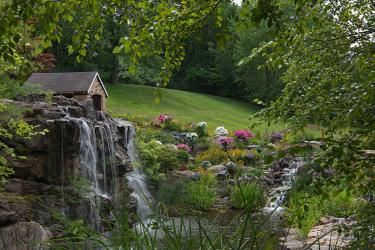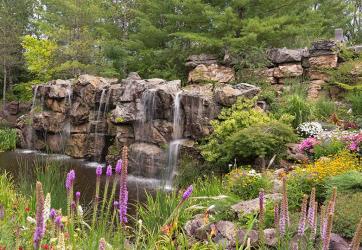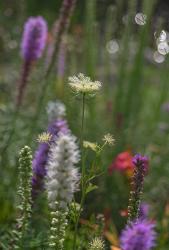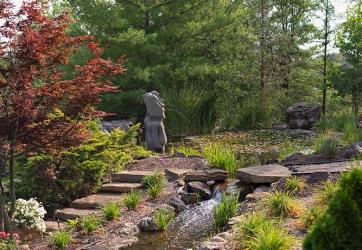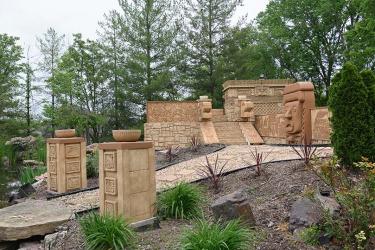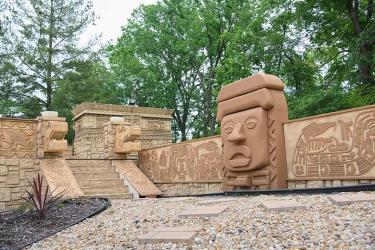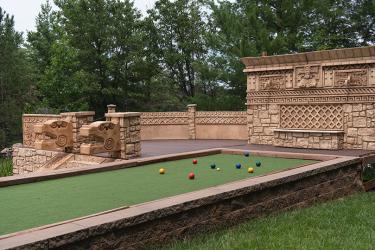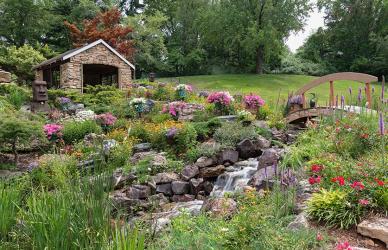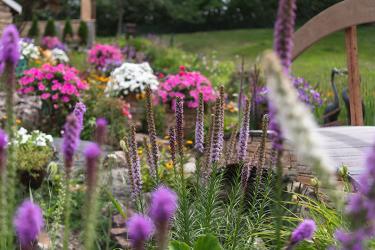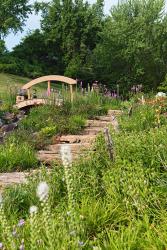Rodney Jarboe didn’t start out to create a movie set in his back yard. When he and his wife Regina purchased a nearly two-acre lot in a Town and Country subdivision 25 years ago, they looked at the level terrain and were thinking of a lovely swimming pool and maybe a tennis court.
“We thought we were choosing a lot that had the flattest elevation compared to some of the other lots. We were later shown the intended elevation of the property and found out that a significant portion of the dirt from our property was going to be moved to the other side of the street to level out those lots. Little did we understand that this would create a 40-50 foot drop from the top of our property to the street elevation,” Rod recalls.
While most homeowners would have rung their hands and perhaps walked away from the purchase, most homeowners aren’t Rod Jarboe. He looked at that challenging elevation drop and began thinking “opportunity.” Creating spectacular environments is something he deals with on an everyday basis. As the president of Replications Unlimited, he had used his background in chemistry to pioneer new technology and patented materials that have allowed fabricators around the world to replicate realistic rocks, trees and coral plus architectural details. The lightweight materials he developed have found their way into theme parks created by Disney, Universal Studios, Busch Gardens, Seaworld, museums, zoos, aquariums, resort hotels, restaurants and movie sets such as "Lord of the Rings".
If it would work for those folks, why wouldn’t his patented artificial rock technology translate into a wonderful water feature in his own backyard, he reasoned. Rod called on John Saul of Saul’s Custom Designs/Design Reflections, the Aquatic Source to provide the water garden expertise. The two laid out a plan, creating two, long, cascading streams, ponds at three different levels and two 60-foot-wide, 12-foot-high cliff-like waterfalls, all incorporated into a 30-foot drop in the back yard. While natural rock is used for the streams, stepping stones and pathways, the cliff-like waterfall is artificial stone.
“It was one of my biggest projects as far as challenges go; it was a new thing for him (Rod) and a new thing for me,” explains John, discussing the creation of the faux cliff. John envisioned the huge formation as looking as if a melting glacier had left a cliff and pieces of crumpled rock with water continuing to flow out and through the rock. “That way we could bring in real rock along the sides and put vegetation around it, so it looked like it had been there forever.” John continues.
Molded off natural stone, the cliff is actually three massive, factory created sections brought in on flatbed trucks. Because of the light weight of the artificial rock, two concrete retaining walls first needed to be installed to hold the hillside in place. Overall, the initial installation took two years to complete. To keep the waterfall and streams going requires four pumps, two for the waterfall and two for the streams. “It’s been here for 24 years. It’s proved to be long-term technology,” Rod notes, regarding the durability of the artificial rock. “I had a lot of fun doing this. People come in and they say, ‘Where did you get all that stone?’”
The initial installation, however, was only the beginning of Rod’s landscaping experiment. “The back yard became a place to test my other products like stone sliding panels and stone columns,” he explains. “I built a stone gazebo, a rock grotto for our spa and 10 stone columns as flower planter boxes to test potential products to sell commercially.”
The ideas just kept coming. “With my exposure to working with museums, theme parks and movie sets, I learned a lot of techniques and ideas to fabricate themed environments,” Rod continues. “Since I have been intrigued with ancient civilizations, I designed and fabricated an Egyptian-themed basement home theater many years ago. From there I went on to fabricating themed items for my back yard.” Three 4-foot Moai statues (like those on Easter Island) went into the landscaping and three 6-foot Moai statues spout water into a lily-filled pond.
When he wanted to add a bocce ball court at the top of the slope in 2021, he decided creating a Mayan-ruin-themed space would “take a plain playing court to the next level. I had visited a number of Mayan locations in Mexico and Belize, so I designed it primarily around Chichen Itza along with some elements based on two other locations.” Rod explains. Having a themed attraction, complete with Mayan glyphs of eagles and jaguars, at the top of the slope, he knew would be a way to get garden visitors to climb the hill and to experience the entire landscape.
Rod is hands-on in executing his designs, using the photographs he took on his trips and transforming them into patterns using CAD software. The designs are then traced on urethane panels, which he sculpts using hand routers and carving tools. “When I am doing this with all my fancy tools, I keep thinking about the ancient civilizations and how they created such smooth sculptures and beautiful things on those sites using only the tools they had available,” he marvels. “It gives you a real appreciation for what they did.”
It took him two years to design and install the first phase of the Mayan complex at the top of the hill. He has at least four more ideas to expand the space over the next few years.
Rod also is hands on when it comes to landscaping his huge water feature. “I don’t go in for a lot of exotic plants,” he says. “I want things that are really solid and proven to do well. Perennials include natives such as purple and white liatris, yellow and purple coneflowers, Queen Anne’s lace, and blue-purple stokesia. Hostas and daylilies also are favorites. Grasses dot the landscape and provide contrast.
Each year he adds between 400 and 500 annuals, which he plants himself with an assist from his sister Deana and friends. His wife Regi handles the containers on the patio. “We do a lot of entertaining in the fall and by then many of the perennials are finished booming,” he says. “The annuals still provide color.”
His favorite annuals include vinca, which thrives in the heat of summer, petunias and coleus for the texture and the variety of colors. “The coleus starts taking over and adds impact in late summer. I am learning more about plants that fill big areas,” he notes.
While many would look at the massive project as overwhelming, Rod sees it as a refuge from his heavy professional workload. “Planting is a way to get away from thinking about business. My back yard is my weekend warrior workout,” he says, noting that there is great satisfaction in “turning a very sloping back yard into a useful and picturesque environment.”


